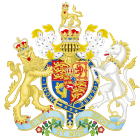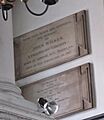Grosvenor Chapel facts for kids
Quick facts for kids Grosvenor Chapel |
|
|---|---|
 |
|
| Location | London |
| Country | England |
| Denomination | Church of England |
| Tradition | Anglo-Catholic / Liberal Catholic |
| Architecture | |
| Heritage designation | Grade II* |
| Architect(s) | Benjamin Timbrell |
| Style | Classical |
| Years built | April 1731 |
| Administration | |
| Parish | St George's, Hanover Square |
| Diocese | Diocese of London |
| Division | Deanery of Westminster (St Margaret) |
The Grosvenor Chapel is a historic church in London, England. It's part of the Church of England and was built way back in the 1730s! This beautiful chapel is located on South Audley Street in an area called Mayfair. It even inspired the design of many churches in New England across the ocean.
Contents
A Look at the Chapel's History
The first stone for the Grosvenor Chapel was placed on April 7, 1730. This was done by Sir Richard Grosvenor, 4th Baronet, who owned all the land around it. He rented the spot for 99 years for a very small, symbolic payment. A group of four builders, led by Benjamin Timbrell, took on the project.
The new church building was finished and ready to use by April 1731.
How the Chapel Became Official
| Grosvenor Chapel Act 1831 | |
|---|---|
| Act of Parliament | |

|
|
| Long title | An Act for the Establishment of a Chapel of Ease, to be called Grosvenor Chapel, in the Parish of Saint George Hanover Square in the County of Middlesex, and for providing for the Maintenance of the said Chapel, and a Stipend for the Minister thereof. |
| Citation | 1 & 2 Will. 4. c. iii |
| Dates | |
| Royal assent | 30 July 1831 |
| Other legislation | |
| Repealed by | Grosvenor Chapel Act 1899 |
|
Status: Repealed
|
|
| Text of statute as originally enacted | |
After the 99-year rental agreement ended in 1829, a special law was passed. This law, called the Grosvenor Chapel Act 1831, made the chapel an official part of the local church system. It became a chapel of ease for St George's, Hanover Square. This meant it was a smaller church that helped the main parish church.
Famous Visitors and Worshippers
Many well-known people have visited or worshipped at the Grosvenor Chapel over the years. These include:
- John Wilkes, a famous politician.
- Lady Mary Wortley Montagu, a writer.
- Garret Wesley, 1st Earl of Mornington, and his wife, who were the parents of the Duke of Wellington.
- Florence Nightingale, the famous nurse.
- US General Dwight D. Eisenhower, who later became president.
- Bishop Charles Gore, an important church leader.
During the Second World War, American soldiers were welcomed to the chapel for their Sunday services. A special plaque outside the church remembers this. After the war, famous people like writer Rose Macaulay and Sir John Betjeman, a Poet Laureate, were often part of the church community.
The Chapel's Design and Building
The Grosvenor Chapel has a simple, classic design. It's shaped like a plain rectangle with two rows of arched windows on the sides. At the front (east end), there's a small area for the communion table. At the back (west end), there's a porch over the sidewalk and a short spire. This spire holds a clock and a bell to call people to worship.
The design was inspired by other churches built around that time. These include St Martin in the Fields and St George's, Hanover Square. A skilled builder like Benjamin Timbrell, who had worked on St Martin's, could easily create this design. He didn't even need a special architect. Later, in 1912–1913, Ninian Comper added special decorations and fittings inside the chapel. These additions reflected the chapel's Anglo-Catholic style of worship.
Music at the Chapel
The organ in Grosvenor Chapel was first built by Abraham Jordan in 1732. It was paid for by Sir Richard Grosvenor, 4th Baronet. The organ was changed a couple of times in the 1800s. In 1930, J. W. Walker & Sons built a new organ, using some parts from the old one. Then, in 1991, William Drake built a completely new organ. This new organ was designed to sound like organs from the 1700s.
You can find all the details about the organ on the National Pipe Organ Register.
The chapel is known for its excellent music. It has a group of five professional singers and an organist. For special events like Easter, more singers and musicians, including an orchestra, often join them. The choir performs many different types of music, from very old Renaissance pieces to modern songs.
There are also free lunchtime concerts every Tuesday at 1:10 pm.
Chapel Leaders: Past and Present
The main priest at Grosvenor Chapel has had different titles over the years.
Curates-in-Charge (Past Leaders)
Before 2006, the senior priest was called the Curate-in-Charge.
- 1941 to 1943: The Revd Cecil Wood
- 1944 to unknown: The Revd G. G. Pearson
- 1968 to 1979: The Revd John Bernard Gaskell
- 1980 to 1992: The Revd Dr Anthony Wendt "Tony" Marks
- 1994 to 2008: The Revd Simon Hobbs
Priests-in-Charge (Current Leaders)
Since 2006, the senior priest at Grosvenor Chapel is known as the Priest-in-Charge.
- 2008 to 2010: The Revd Mark Oakley
- 2012 to present: The Revd Dr Richard Fermer
- 2023 to present: Fr Stephen Coleman
Notable Burials
Some important people have been buried at Grosvenor Chapel:
Images for kids





